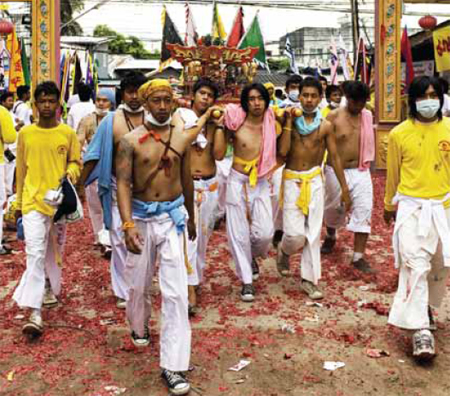พญานาค,Payanak
ตามความเชื่อของคนไทย พญานาคคืองูใหญ่ พญางู เจ้าแห่งงู ที่สุดของที่สุดของงู
มีอิทธิฤทธิ์ มีพิษร้ายแรง จะว่าเป็นสัตว์ที่มีเลือดเนื้อก็ไม่น่าใช่ จะเป็นเทพ เทวดาหรือก็ไม่เข้ากรอบ
มีที่อยู่คือเมืองบาดาล แปลงกายเป็นคน มาอยู่ร่วมกับชาวบ้านทั่วไปได้ มีตำนานในทางพุทธศาสนา
ว่ามีความเลื่อมใส ในพระศาสนา จนอยากออกบวช แต่ติดที่กฎของการจะบวชเป็นพระได้ต้องเป็นมนุษย์เท่านั้น จึงไม่ได้รับอนุญาติให้บวช เป็นที่มาของตำนานการ
บวชนาค หาอ่านได้ในตอนต่อๆไป
นาค หรือ พญานาค (อังกฤษ: N?ga, สันสกฤต: ???) เป็นความเชื่อในภูมิภาคเอเชียใต้และเอเชียตะวันออกเฉียงใต้ โดยเรียกชื่อต่าง ๆ กัน แต่มีลักษณะร่วมกัน คือ เป็นงูขนาดใหญ่มีหงอน เป็นสัญลักษณ์แห่งความยิ่งใหญ่ ความอุดมสมบูรณ์ ความมีวาสนา อีกทั้งยังเป็นสัญลักษณ์ของบันไดสู่จักรวาลอีกด้วย
ต้นกำเนิดความเชื่อเรื่องพญานาคน่าจะมาจากอินเดีย ด้วยมีปกรณัมหลายเรื่องเล่าถึงพญานาค โดยเฉพาะในมหากาพย์มหาภารตะ นาคถือเป็นปรปักษ์ของครุฑ ส่วนในตำนานพุทธประวัติ ก็เล่าถึงพญานาคไว้หลายครั้งด้วยกัน
ในเอเชียตะวันออกเฉียงใต้ยังมีตำนานเรื่องพญานาคอย่างแพร่หลาย ชาวบ้านในภูมิภาคนี้มักเชื่อกันว่าพญานาคอาศัยอยู่ในแม่น้ำโขง หรือเมืองบาดาล และเชื่อกันว่าเคยมีคนเคยพบรอยพญานาคขึ้นมาในวันออกพรรษาโดยจะมีลักษณะคล้ายรอยของงูขนาดใหญ่
ลักษณะของพญานาคตามความเชื่อในแต่ละภูมิภาคจะแตกต่างกันไป แต่พื้นฐานคือพญานาคนั้นมีลักษณะตัวเป็นงูตัวใหญ่มีหงอนสีทองและตาสีแดง เกล็ดเหมือนปลามีหลายสีแตกต่างกันไปตามบารมี บ้างก็มีสีเขียว บ้างก็มีสีดำ หรือบ้างก็มี 7 สี เหมือนสีของรุ้ง และที่สำคัญคือนาคตระกูลธรรมดาจะมีเศียรเดียว แต่ตระกูลที่สูงขึ้นไปนั้นจะมีสามเศียร ห้าเศียร เจ็ดเศียรและเก้าเศียร นาคจำพวกนี้จะสืบเชื้อสายมาจาก พญาเศษนาคราช (อนันตนาคราช) ผู้เป็นบัลลังก์ของพระวิษณุนารายณ์ปรมนาท ณ เกษียรสมุทร อนันตนาคราชนั้นเล่ากันว่ามีกายใหญ่โตมหึมามีความยาวไม่สิ้นสุด มีพันศีรษะ พญานาคนั้นมีทั้งเกิดในนำและบนบก เกิดจากครรภ์และจากไข่ มีอิทฤทธิ์สามารถบันดาลให้เกิดคุณและโทษได้ นาคนั้นมักจะแปลงร่างเป็นมนุษย์รูปร่างสวยงาม
ความเชื่อเกี่ยวกับคุณลักษณะและคุณสมบัติ
ชาวฮินดูถือว่า นาคเป็นผู้ใกล้ชิดกับเทพองค์ต่างๆ เป็นเทพเจ้าแห่งน้ำ เช่น อนันตนาคราช ที่เป็นบัลลังก์ของพระนารายณ์ตรงกับความเชื่อของลัทธิพราหมณ์ ที่เชื่อว่า นาค เป็นเทพแห่งน้ำ เช่นปีนี้ นาค ให้น้ำ 1 ตัว แปลว่า น้ำจะมาก จะท่วมที่ทำการเกษตร ไร่นา ถ้าปีไหน นาคให้น้ำ 7 ตัว น้ำจะน้อย ตัวเลขนาคให้น้ำจะกลับกันกับเหตุการณ์ เนื่องจาก ถ้านาคให้น้ำ 7 ตัว น้ำจะน้อยเพราะนาคกลืนน้ำไว้
นาคมีคุณสมบัติพิเศษ คือ สามารถแปลงกายได้ มีอิทธิฤทธิ์และมีชีวิตใกล้กับคน สามารถแปลงเป็นคนได้ เช่นคราวที่แปลงเป็นคนมาขอบวชกับพระพุทธเจ้า ในหนังสือไตรภูมิพระร่วง กล่าวถึงนาคที่ชื่อ ถลชะ ที่แปลว่า เกิดบนบก จะเนรมิตกายได้เฉพาะบนบก และนาคชื่อ ชลซะ แปลว่า เกิดจากน้ำ จะเนรมิตกายได้เฉพาะในน้ำเท่านั้น
นาค ถึงแม้จะเนรมิตกายเป็นอะไร แต่ในสภาวะ 5 จะต้องปรากฏรูปลักษณ์เป็นนาคเช่นเดิม คือ ขณะเกิด, ขณะลอกคราบ, ขณะสมสู่กันระหว่างนาคกับนาค ขณะนอนหลับโดยไม่มีสติ และตอนตาย ก็กลับเป็นงูใหญ่เหมือนเดิม
นาค มีพิษร้าย สามารถทำอันตรายผู้อื่นได้ด้วยพิษ ถึง 64 ชนิด ซึ่งตามตำนานกล่าวว่า สัตว์จำพวกงู แมงป่อง, ตะขาบ, คางคก, มด ฯลฯ มีพิษได้ ซึ่งก็ด้วยเหตุที่ นาคคายพิษทิ้งไว้ แล้วพวกงูไปเลีย พวกที่มาถึงก่อนก็เอาไปมาก พวกมาทีหลัง เช่น แมงป่อง กับ มด ได้พิษน้อย แค่เอาหาง เอากันไปป้ายเศษพิษ จำพวกนี้จึงมีพิษน้อย และพญานาคต้องคายพิษทุก 15 วัน
นาค อาศัยอยู่ใต้ดิน หรือบาดาล คนโบราณเชื่อว่าเมื่อบนสวรรค์มีเทพอาศัยอยู่ลึกลงไปใต้พื้นโลก ก็น่าจะมีสิ่งมีชีวิตอาศัยอยู่ ในหนังสือไตรภูมิพระร่วง กล่าวว่า ที่ที่นาคอยู่นั้นลึกลงไปใต้ดิน 1 โยชน์ หรือ 16 กิโลเมตร มีปราสาทราชวังที่วิจิตรพิสดารไม่แพ้สวรรค์ ที่มีอยู่ถึง 7 ชั้น เรียงซ้อนๆ กัน ชั้นสูงๆ ก็จะมีความสุขเหมือนสวรรค์
นาค สามารถผสมพันธุ์กับสัตว์ชนิดอื่นได้ แปลงกายแล้วสมสู่กับมนุษย์ได้ เมื่อนาคตั้งท้องจะออกลูกเป็นไข่เหมือนงู มีทั้งพันธุ์เศียรเดียว 3, 5 และ 7 เศียร
สามารถขึ้นลง ตั้งแต่ใต้บาดาลพื้นโลกจนถึงสวรรค์ ในทุกตำนานมักจะกล่าวถึงนาคที่ขึ้น-ลง ระหว่างเมืองบาดาล กับเมืองสวรรค์ ที่จะแปลงกายเป็นอะไรตามที่คิด ตามสภาวะเหตุการณ์นั้น ๆ[1]
ความเชื่อเกี่ยวพันกับชีวิต น้ำและธรรมชาติ
นาคเป็นสัญลักษณ์ของน้ำ จึงปรากฏความเชื่อเรื่องนาคที่เกี่ยวกับน้ำไว้ในด้านต่าง ๆ ดังนี้
ในตำนานสิงหนวัติ กล่าวว่า เมื่อเจ้าเมืองสิงหนวัติอพยพคนมาจากทางเหนือ พญานาคแปลงกายมาช่วยชี้ที่ตั้งเมืองใหม่ และขอให้อยู่ในทศพิธราชธรรม พอตกกลางคืนก็ขึ้นมาสร้างคูเมือง 4 ด้าน เป็น เมืองนาคพันธุ์สิงหนวัติ ต่อมาเมื่อยกทัพปราบเมืองอื่นได้ และรวมดินแดนเข้าด้วยกัน จึงเปลี่ยนชื่อเป็น แคว้นโยนกนาคราช[[ไฟล์:
ที่ปราสาทพนมรุ้ง คูเมืองที่เป็นสระน้ำ 4 ด้าน รอบปราสาทและมี พญานาค อยู่ด้วย ตามความเชื่อของคนสมัยโบราณ ดังนั้น นาคจะมีความหมายเป็นอย่างอื่นไม่ได้นอกจากน้ำ เช่น การสร้างศาสนสถานไม่ว่าจะเป็นอุโบสถ นาคที่ราวบันได จึงมี พญานาค ซึ่งตามความเป็นจริง (ความเชื่อ) การสร้างต้องสร้างกลางน้ำ เพื่อให้ดูเหมือนว่าศาสนสถานนั้นลอยอยู่เหนือน้ำ แต่ก็ไม่ต้องสร้างจริงๆ เพียงแต่มีสัญลักษณ์ พญานาค ไว้ เช่น ที่ปราสาทพนมรุ้ง จังหวัดบุรีรัมย์ เป็นต้น
แม้เกี่ยวกับชีวิตมนุษย์ ก็จะมีอยู่ในราศีเกิด เช่นของคนนักษัตรปีมะโรง ที่มีความหมายถึง ความยิ่งใหญ่และพลังอำนาจ ที่มี พญานาค เป็นสัญลักษณ์
อย่างไรก็ตามยังมีความเชื่ออีกไม่น้อยที่คิดว่า พญานาคจะปรากฎให้เห็นกัน แบบตัวเป็นๆ ซึ่งขัดแย้งกับข้อมูลว่า เป็นสัตว์ที่ไม่ใช่สัตว์ คือมันไม่จำเป็นต้องมีร่างกาย และดำรงค์ชีวิตตามแบบสัตว์โลกทั่วไป ไม่ต้องกินอาหาร ไม่ต้องออกมาดำผุดดำว่าย แต่ความเชื่อ และความลึกลับในโลกนี้ก็ยังเดินเคียงกันไป
 |
| ภาพจากการบันทึกที่เชื่อว่าเป็นพญานาคในแม่น้ำโขง จ.มุกดาหาร |
 |
| เกลียวคลื่นที่กลางบึง จ.สกลนคร |
 |
| ภาพที่มักใช้เพื่อเชื่อมโยงการมีตัวตนของพญานาคในหมู่คนพื้นเมือง |
 |
| แท้จริงก็เป็นเพียงปลาทะเลน้ำลึกชนิดหนึ่ง |
 |
| จับกันได้อยู่เสมอ |
Oarfish
Oarfish are large, greatly elongated,
pelagic Lampriform fishes comprising the small
family Regalecidae.
[1] Found in all temperate to tropical oceans yet rarely seen, the oarfish family contains four
species in two
genera. One of these, the
king of herrings (
Regalecus glesne), is listed in the
Guinness Book of World Records as the longest
bony fish alive, at up to 17 metres (56 ft) in length.
[2][3]
The
common name oarfish
is presumably in reference to either their highly compressed and
elongated bodies, or to the former (but now discredited) belief that the
fish "row" themselves through the water with their pelvic fins.
[4] The family name
Regalecidae is derived from the
Latin regalis,
meaning "royal". The occasional beachings of oarfish after storms, and
their habit of lingering at the surface when sick or dying, make oarfish
a probable source of many
sea serpent tales.
Although the larger species are considered
game fish
and are (to a minor extent) fished commercially, oarfish are rarely
caught alive; their flesh is not well regarded due to its gelatinous
consistency.
Anatomy and morphology
The tapering, ribbony silver bodies of oarfish—together with an impressive, pinkish to cardinal red
dorsal fin—help explain the perception of majesty taken from rare encounters. The dorsal fin originates from above the (relatively small)
eyes
and runs the entire length of the fish. Of the approximately 400 dorsal
fin rays, the first 10 to 12 are elongated to varying degrees, forming a
trailing crest embellished with reddish spots and flaps of skin at the
ray tips. The pelvic fins are similarly elongated and adorned, reduced
to 1 to 5 rays each. The
pectoral fins are greatly reduced and situated low on the body. The
anal fin is completely absent and the
caudal fin may be reduced or absent as well, with the body tapering to a fine point. All fins lack true
spines. At least one account, from researchers in New Zealand, describes the oarfish as giving off "electric shocks" when touched.
[4]
Like other members of its order, the oarfish has a small yet highly protrusible oblique mouth with no visible
teeth. The body is
scaleless and the skin covered with easily abraded, silvery
guanine. In the
streamer fish (
Agrostichthys parkeri), the skin is clad with hard
tubercles. All species lack
gas bladders and the number of
gill rakers is variable.
Oarfish coloration is also variable; the flanks are commonly covered
with irregular bluish to blackish streaks, black dots, and squiggles.
These markings quickly fade following death. The king of herrings is by
far the largest member of the family at a published total length of 11
metres (with unconfirmed reports of 15 metres or more) and 272 kilograms
in weight. The streamer fish is known to reach 3 metres total length
whilst the largest recorded specimen of
Regalecus russelii
measured just 540 centimetres standard length. It is probable that this
little-known species can regularly reach a maximum length of at least
15.2 metres (50 ft).
From Wikipedia, the free encyclopedia
 |
| payanak |
Payanak
The mythical animal payanak is represented in roofing omaments, statuary and
paintings in Buddhist temples throughout Cambodia, Thailand and Laos. It usually
has a single dragon- like head, with a hom on the snout and a beard-Iike projection
from the chin, and a long, limbless snake- or fish-Iike body covered with scales.
Although often referred to as a naga, it is derived from the "elephant-lion.. or gajasimha
of the Khmer king Suryavarman II (reigned 1113-ca 1150). The payanak is associated
with numerous popular accounts and legends of Thailand and Laos and is frequently
portrayed in the popular as well as temple art of these countries.
A photograph bearing the false label "Payanak, Queen of the Nagas,
seized by American Arrny at Mekong River, Laos Military Base on June 27,1973.. has been
widely distributed in Laos, Thailand, and elsewhere. The photo in question actually is
of a freshly dead oarfish, Regalecus glesne, stranded on Coronado Island, Califomia, on
September 19, 1996.
see all















